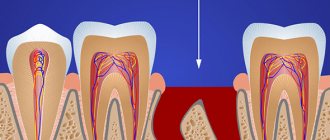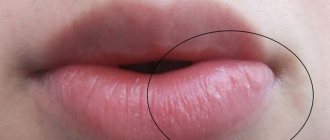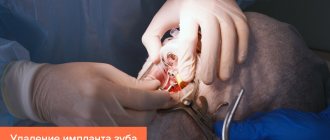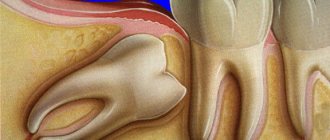Normal or pathological Associated symptoms When not to worry Sign of complication Warning at the Center How to remove at home Pathological process Solving the problem Frequently asked questions
Swelling after sinus lift and bone grafting can be due to both the body’s natural response to tissue damage and complications. In our Center, the possibility of developing complications is minimized. We have eliminated possible risks at every stage - from preparation to rehabilitation. The use of high-tech equipment allows bone augmentation operations to be performed safely, with minimal trauma.
Swelling after surgery - normal or pathological?
Sinus lifting and other types of bone grafting are considered low-traumatic procedures performed by an experienced doctor. But in any case, this is not only a therapeutic procedure, but also a kind of trauma. As with any other surgical procedure, tissue damage is inevitable. After surgery, swelling develops, which is a physiological reaction of the body's defense systems.
Osteoplastic surgeries vary in complexity and extent of damage to the soft and bone tissues of the oral cavity:
- With an open sinus lift, incisions are made in the gums on the front side of the upper jaw to create access to the maxillary sinus, requiring sutures at the final stage of surgery.
- Closed sinus lifting is also accompanied by a violation of tissue integrity, since access to the bottom of the maxillary sinus is made by creating a hole in the gum and bone at the site of implant installation.
- Implantation of an implant during simultaneous implantation and sinus lift operations also provokes swelling as a protective reaction to a new object for the body.
- Other methods of bone grafting are carried out in various ways, but in any case they cannot be done without soft tissue incisions. Some outdated methods involve transplanting an autograft from one point of the jaw to the required area; we do not use such methods.
The severity of edema depends on the extent of the operation performed and the individual characteristics of the body . For example, women are more prone to puffiness than men. Typically, swelling is not a complication; during the normal course of the rehabilitation period it gradually decreases.
Our work is aimed at minimizing complications
We took the necessary measures at every stage - from preliminary preparation and implementation of low-traumatic protocols to a complex of proprietary rehabilitation.
Levin Dmitry Valerievich
Founder and Chief Doctor of the Center
Can your face swell after a dental implant?
Swelling after dental implantation is a natural reaction of the body. Mild or moderate severity is not a pathology and should not cause concern. Before the implantation of the structure, the gum tissue is injured, and the body tries to restore it. Regeneration is impossible without swelling. It accompanies any dental intervention, even tooth filling. The implantation methods used by specialists help to minimize tissue damage during surgery.
Sometimes facial swelling can indicate inflammation, which is undesirable. Therefore, you need to carefully monitor your well-being. If other unpleasant symptoms appear (severe pain, high temperature), you should immediately consult a doctor.
Signs of unfavorable development of complications:
- the gums at the site of swelling turn blue;
- the tumor on the gum is hard to the touch;
- facial swelling lasts more than a week.
These symptoms indicate increased activity of the immune system, which provokes implant rejection. This may be due to allergies or an autoimmune disease. Patients with such a history should be under medical supervision after surgery. If the implant does not take root, re-implantation is not performed in such cases.
Associated symptoms
In addition to swelling in the first days after surgery, you may be concerned about:
- local pain in the area of the operation;
- redness of the gum tissue;
- temperature rise to subfebrile levels;
- slight secretion of lymph mixed with blood (ichor).
Depending on the volume of the operation, the amount of osteoplastic material introduced and implants installed, the severity of the above symptoms may vary.
The contract for treatment at our Center must indicate all acceptable postoperative conditions. Please read them carefully and the list of possible inconveniences.
When should you not worry?
Edema is not a complication if:
- It gradually decreases and completely disappears after 3-7-10 days (depending on the complexity of the operation).
- It is localized at the site of surgery and implantation and does not spread to healthy, nearby tissues.
- It is not accompanied by severe pain and high body temperature.
- It is not accompanied by bleeding or purulent discharge from the area of the postoperative wound.
In general, there is no need to worry if the swelling does not interfere with your normal lifestyle (subject to the necessary restrictions during the rehabilitation period) and gradually decreases in size. In this case, it is enough to follow the doctor’s recommendations in the postoperative period and appear in a timely manner for a scheduled examination. Usually three days for women and two days for men is enough to reduce swelling.
Usually, the attending physician knows everything in advance when planning an operation.
Feel free to ask about the number of days with noticeable post-operative swelling. Based on these calculations, we issue certificates of incapacity for work or plan operations before the weekend. Warn us about possible trips and important events; it is better to plan the operation without compromising your work and personal life. You should understand that you will have to make lifestyle changes after the procedure. Social activity after the operation should be planned to be reduced. You will not be able to be active with swelling as before the operation; it is better to sit at home for a couple of days.
Levin Dmitry Valerievich
Founder and Chief Doctor of the Center
How to brush your teeth after implantation
One of the most important issues concerns oral hygiene in the postoperative period. Teeth should be brushed carefully, avoiding the operated area. It is recommended to use a brush with soft bristles, which cannot injure the mucous membranes of the mouth. Hygiene procedures should be carried out in the morning and evening. When brushing your teeth, you should not forget to remove plaque from the tongue, palate and the inside of the cheeks.
In the first week after eating, it is recommended to rinse the mouth with antiseptics, and then with mouth rinses. When the wound has healed, you can use brushes, dental floss, and irrigators to clean your teeth.
When swelling is a sign of complications
Despite the fact that the appearance of edema and other symptoms is a physiological phenomenon due to tissue damage, they should not cause unbearable discomfort to the patient. If the symptoms are pronounced and significantly worsen the quality of life in the postoperative period, you need to talk about complications and immediately consult your doctor.
Alarming signs in which you should think about the development of a complication or an abnormal reaction that requires immediate correction:
- High rate of development, rapid increase in size of edema, transition of edema to the soft tissues of the face.
- The swelling is dense, the consistency of an eraser.
- Lack of positive dynamics - does not begin to decrease from the 3rd day after the operation.
- Impaired speech and chewing function due to edema.
Associated factors also indicate the occurrence of a problem.:
- An increase in body temperature above 38 degrees for longer than a day.
- Severe pain at intervals of less than three hours (even when taking painkillers).
- Discharge of a large amount of ichor, bleeding from the wound.
- The addition of a bacterial infection, manifested in suppuration in the wound area.
- Strange odors from the post-operative area.
If one or more of the above symptoms appear, you should immediately contact the dentist who performed the sinus lift or bone grafting. Find him and explain the situation, don’t delay. It is dangerous to self-medicate in such a situation , so entrust the treatment of the emerging complication to an experienced specialist.
If you are undergoing treatment at our Center, immediately contact the 24-hour support service by calling from your card.
Why does swelling occur?
If your gums become swollen after installing the implant, do not worry. Swelling is normal. In itself, it represents the flow of lymphatic fluid to injured tissues. Accumulating in a certain area, lymph becomes the cause of visible swelling and puffiness. This is necessary for cell regeneration, their restoration and is the body’s natural defense.
Facial swelling after dental implantation
Swelling of the gums occurs after implantation, tooth extraction, or sinus lift. The result of any surgical intervention is tissue injury. Therefore, a person can only wait for the swelling to subside and alleviate his condition with the remedies recommended by the doctor.
Measures to prevent the consequences of sinus lifting in our Center
To avoid situations where swelling turns from a natural reaction into a problem for the patient, we have developed Uniform Quality Standards. We do not work in a rush, we provide personalized dental care, and devote the necessary time to seeing each patient. We provide a lifetime guarantee for bone grafting and implantation operations .
Preoperative preparation
If during the preparation stage obstacles to sinus lifting or bone grafting are identified, they are first eliminated, and only then the day of surgery is set.
Preoperative preparation includes:
- Computer diagnostics A CT scan is performed on a high-precision GALILEOS tomograph in ENT mode to assess the condition of the bone tissue adjacent to the area of the operation of the teeth. On the day of the initial consultation, immediately after the computed tomography, the attending physician, having familiarized himself with the anatomical features, will warn you about possible individual inconveniences and the likelihood of the body’s natural reaction to the intervention.
- Examination by an ENT doctor If diseases of the ENT organs are suspected based on the results of a computed tomography scan, before a sinus lift, an examination is carried out by a regular ENT doctor. If a cyst is detected in the maxillary sinus or inflammatory processes, conservative or surgical treatment is prescribed.
- Sanitation of the oral cavity If any dental pathologies are detected (inflammatory gum diseases, caries, inflammatory formations on the roots of teeth), which are foci of infection, their treatment is mandatory. This reduces the risk of developing postoperative complications of infectious origin. Also, complete sanitation of the oral cavity may include professional teeth cleaning to get rid of plaque and tartar.
Experienced doctors
Bone grafting and sinus lift operations in our Center are performed only by maxillofacial surgeons . These are experienced doctors with continuous work experience of 5 years, deep knowledge of the structure of the maxillofacial system and honed manual skills.
Low-impact technologies
The use of gentle technologies without a hammer or chisel prevents injury to soft and hard tissues and, accordingly, minimizes the occurrence of complications.
- Ultrasonic piezosurgery To work with hard tissues when creating access to the maxillary sinus, we use the NSK VarioSurg ultrasound device. It has a mild softening effect on the bone, without injuring it.
- Using the Lift-Control instrument system A coordinated set of micro-instruments allows you to lift the thin lining of the maxillary sinus as carefully and delicately as possible without damaging it.
- Biocompatible materials and growth stimulants We use only hypoallergenic drugs to increase bone volume in combination with bone morphogenetic protein (BMP). The drugs are certified in Russia and purchased from official representatives.
Maintaining sterility
- Sterilization of instruments is carried out according to the AntiAIDS-AntiHepatitis program. There are 2 separate sterilization rooms, 5 sterilization autoclaving stations .
- All osteoplasty and implantation procedures are performed only in sterile operating rooms. The Center has 3 operating units, which are loaded in a “checkerboard” pattern to allow for sterilization .
Branded rehabilitation
We made sure that each patient was provided with the necessary medications. You will receive a branded package with antibiotics, pain relievers, and wound care products . You won’t have to run to pharmacies after surgery. The package also contains a sheet with postoperative recommendations.
For those who want to go through the rehabilitation period faster, a set of restorative procedures :
- Bioreparation Injections of biostimulants based on hyaluronic acid with amino acids, trace elements and peptides to improve the condition of the skin and reduce swelling.
- PRP plasma lifting Injection of blood plasma into soft tissues to accelerate regeneration processes, improve healing, eliminate swelling and bruises.
- Microcurrent therapy is a physiotherapeutic method of gently applying a weak impulse current to the skin to improve metabolism, improve lymphatic drainage, eliminate swelling, relieve spasms and pain.
24/7 patient support
The post-operative support service operates 24/7. Our specialists will monitor your well-being, remind you to take medications and follow recommendations. This is an additional level of security.
You can ask any questions to the 24-hour medical post support service by calling the numbers listed on the card in the package with medications and recommendations.
How to relieve swelling
Anti-inflammatory drugs, which are always prescribed by a doctor, will help reduce the manifestation of this unpleasant symptom. The most common drugs that are present in the postoperative prescription usually include the following: Diclofenac, Nise, Ketanov, Nimesulide and others. It is important to note that you do not need to take strong medications on an ongoing basis; it is enough to do this when pain or swelling increases.
In order to prevent inflammation or to stop a process that has already begun, the doctor may prescribe antibiotics, for example, Erythromycin or Augmentin. Rinsing with medicinal solutions with an antibacterial effect will also help to shrink the cheek. For these purposes, pharmaceutical Chlorhexidine, Furacilin, as well as herbal decoctions, such as chamomile or calendula, are often used.
To avoid further damaging the newly operated gum area, do not rinse your mouth too vigorously. It is enough to do so-called baths, that is, take liquid into your mouth, hold it for several minutes and spit. According to reviews, such folk methods are very effective, so the result will not be long in coming.
How to remove at home
The instructions for the postoperative period indicate in as much detail as possible what will help reduce the size of the swelling. Please read it carefully.
Cooling compress
The bag of post-op medications contains ice in a blue bag, freeze it in the freezer and reuse. Immediately after bone grafting, it is recommended to apply an ice pack (previously wrapped in a cloth or towel) to the cheek on the side of the operation. The duration of such a compress should not exceed 10-15 minutes, after which you need to take a half-hour break. The effect of using this simple method appears almost instantly - pain subsides, swelling stops increasing.
It should be taken into account that there are contraindications to this method of eliminating swelling, for example, trigeminal neuritis. Cold compresses are recommended for the first 24-48 hours, since it is during this time period that their effectiveness and safety are highest. If you hold the ice for longer than 15 minutes, there is a risk of hypothermia, be careful with this!
Taking medications
In addition to the local effects of low temperature, do not forget about taking medications. After osteoplasty, patients are prescribed anti-inflammatory and painkillers that help reduce or eliminate swelling and cope with other unpleasant symptoms of inflammation. In addition to anti-inflammatory drugs, multivitamins and broad-spectrum antibiotics are prescribed to prevent bacterial complications. You should take medications strictly as prescribed by your doctor or as instructed, without exceeding the permissible dose.
Diet
Also during the rehabilitation period, the prevention of edema is following a proper diet, drinking regimen, complete exclusion of chewing load on the side of the operation, regular brushing of teeth and baths with an antiseptic after each meal.
Read more about the rules of the rehabilitation period here - After a sinus lift
All these measures are aimed at relieving the symptoms of inflammation and thereby reducing swelling after sinus lifting and bone grafting. Eating spicy, too hot, hard food irritates the mucous membrane of the gums and increases swelling, and failure to maintain oral hygiene and neglect to use an antiseptic increases the risk of infectious complications.
Our doctor will inform you in detail about all the nuances of the postoperative period so that tissue restoration after surgery occurs quickly and does not cause discomfort.
Tips to reduce discomfort
General recommendations for speedy rehabilitation are as follows:
- tune in to recovery (recovery): watch your favorite movies, listen to music, read optimistic books,
- provide yourself with comfortable conditions at home in advance: buy medicine (more on this in the next section), cook light broth, stock up on pureed food - cottage cheese, yoghurt, you can buy baby food in jars. There should also be a large bottle of clean warm water at home,
- do not overload the body, let all efforts be directed towards regeneration: you can take 3-4 days off from work, do not lift weights, do not play sports, do not take hot baths. Visiting baths, saunas, swimming pools and air travel should also be avoided at first,
- Perform oral baths as prescribed by your dentist: do not rinse, as infection may get into the wound,
- Brush your remaining teeth very carefully, but with a new brush (there are definitely germs on the old one),
- try to chew food on the non-operated side of the row,
- do not suck out the puree and liquid from the tube, it is better to use a spoon: low pressure in the oral cavity can lead to movement of sutures, membranes,
- give up coffee, cigarettes and alcohol (at least at first): there are many reasons for this - drying out the mucous membranes in the oral cavity, overheating of tissues, increased blood pressure, toxic effects. As a result, rehabilitation and engraftment of implants are slower,
- Take all prescribed medications according to the regimen received from your doctor.
What pathological process can be suspected with persistent swelling?
When performing a sinus lift by an inexperienced doctor, perforation of the maxillary sinus is possible, which is accompanied by characteristic symptoms, including swelling. Consequences of this outcome of the operation:
- inflammation of the maxillary sinus;
- penetration of bone material into the sinus;
- complicated course up to meningitis.
Since some options for bone grafting end with the implantation of an implant, there is a risk of complications associated with its rejection or the development of inflammation around it (peri-implantitis). Both of these pathological processes are associated with a violation of surgical technique and the presence of a focus of infection in the oral cavity. The problem is serious, although extremely rare.
- In the case of peri-implantitis, the inflammation is localized near the dental implant and is accompanied by all the characteristic symptoms - pain, hyperemia, severe swelling.
- Rejection of the implant occurs due to the influence of immune factors on it and depends on the individual characteristics of the patient’s immune system. In some cases, this process develops rapidly, while in other cases, rejection can be suspected by pronounced swelling that does not decrease with time, pain, and deterioration of the patient’s general condition.
If the swelling begins to bother you greatly and other alarming symptoms appear, you should seek qualified help from a doctor. Treatment of pathological processes must be timely and comprehensive .
Are swollen gums and other advanced symptoms signs of peri-implantitis?
Peri-implantitis is characterized by inflammation of the tissue around the implant and loss of supporting bone. Leads to rejection of the structure and can develop due to:
- medical error;
- low quality implants;
- insufficient oral hygiene.
In the early postoperative period, complications are caused by technical errors during the operation. In the long term - by ignoring hygiene standards.
Medical errors that provoke the development of peri-implantitis:
- violation of asepsis, antiseptics;
- incorrect assessment of risk factors;
- incorrect selection and installation of an implant;
- incorrect crowns, dentures causing periodontal trauma.
Patients at risk for peri-implantitis include:
- with bad habits (smoking);
- periodontal diseases;
- immune diseases;
- bruxism;
- diabetes mellitus
According to the clinic, peri-implantitis can be:
- sharp;
- sluggish;
- in remission;
- in a state of abscess.
It is important to distinguish between peri-implantitis and mucositis - inflammation of the mucosal area adjacent to the implant, not accompanied by a decrease in bone tissue.
How to make a diagnosis
To establish a diagnosis, the doctor examines the patient. During the inspection it is noted:
- swelling of soft tissues;
- bleeding gums on probing;
- discharge of pus from the peri-implant pocket;
- mobility of the structure;
- the presence of soft plaque on the implant and teeth that are nearby.
Clinical methods for diagnosing peri-implantitis are:
- dental radiography;
- stomatoscopy;
- orthopantomography;
- three-dimensional computed tomography;
- determination of standard dental indices.
How is peri-implantitis treated?
Treatment of the complication is carried out in two stages. First is carried out:
- professional oral hygiene;
- treatment with ozonated solution;
- laser therapy.
The surgical stage of treatment involves:
- revision of the bone pocket;
- removal of necrotic tissue;
- cleaning the surface of the implant with antiseptic agents;
- washing the bone pocket;
- introduction of osteoconductive material into it.
Afterwards, antibiotic therapy and rinsing with antiseptics are prescribed. In case of relapse, removal of the structure and subsequent reimplantation is required.
- Complete restoration of the dentition in just 4 days!
more detailsRoott Pterygoid Implants Sinus lift is no longer needed!
more details
Once and for life! Express implantation in 4 days with a permanent ReSmile prosthesis
more details
All-on-4, All-on-6, ReSmile, Zygomatic implantation We use all modern methods of dentition restoration
more details
Ways to solve the problem
A detailed x-ray examination is carried out on a computed tomograph in macro mode, the doctor determines whether there is inflammation or whether it is just panic from noticeable swelling. After assessing the clinical situation, the doctor will prescribe treatment aimed at eliminating the cause of the swelling.
- In severe cases, repeated surgical intervention may be resorted to (in case of implant rejection, purulent complications).
- In cases where the swelling does not bother the patient too much and gradually decreases during the first 7-10 days, additional medical intervention is not required and this symptom will disappear on its own as the tissue heals.
Patients often come to our Center with complications after unsuccessful operations. We specialize in helping with problems related to maxillary sinus dysfunction. The specialized ENT department is equipped with the necessary equipment to eliminate sinus lift complications.
How quickly does swelling go away and how many days does it last?
The appearance of a tumor is possible within a few hours after surgery. First it appears on the gum, after a day it spreads to the cheek and face. Usually lasts for several days without further growth. Healing of damaged tissue takes an average of a week. During this period, swelling persists.
The peak state , that is, the greatest development of inflammation, should be expected on the third postoperative day. Even a doctor cannot know how long the swelling will last. The specialist will give recommendations regarding the elimination of pain, the implementation of which will significantly facilitate the healing process.
If after 10 days your health does not improve, you should consult a doctor, as there is a risk of inflammation due to infection.










